The stoneware known asBolesawiec potterynamed after the medieval city of Bolesawiecis popular among collectors and bakers alike.
The early pottery products of these workshops werestoneware vesselsfired from the fine local clay.
The jugs and tankards were decorated with raised patterns and covered in a brownslip glaze.
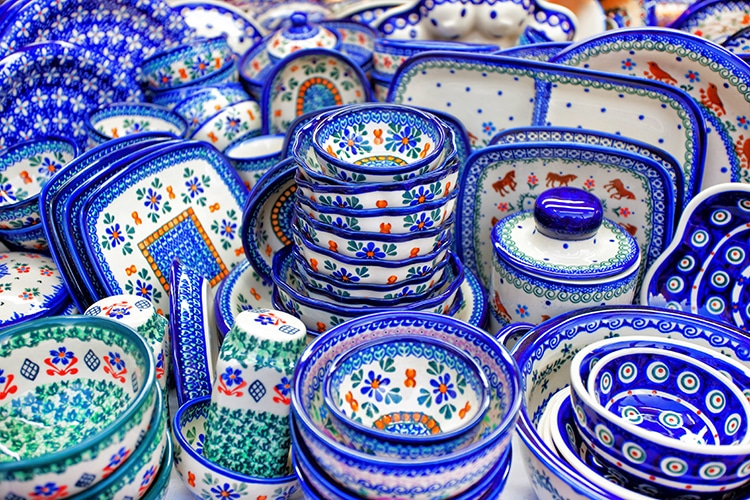
Photo:Stock Photosfrom ABC PHOTO/Shutterstock
Tin, silver, or pewter tops could be added.
A teapot showing a peacock eye design.
(Photo:Stock Photosfrom MUCHOMOROS/Shutterstock)
The 18th century brought innovation in styles and materials.

A teapot showing a peacock eye design. (Photo:Stock Photosfrom MUCHOMOROS/Shutterstock)
Bolesawiec became a part of theKingdom of Prussiain 1742.
This new unity with Germanic lands brought an influx of potters to the region.
To meet new consumer needs, potters produced new items such as coffee and tea pots.
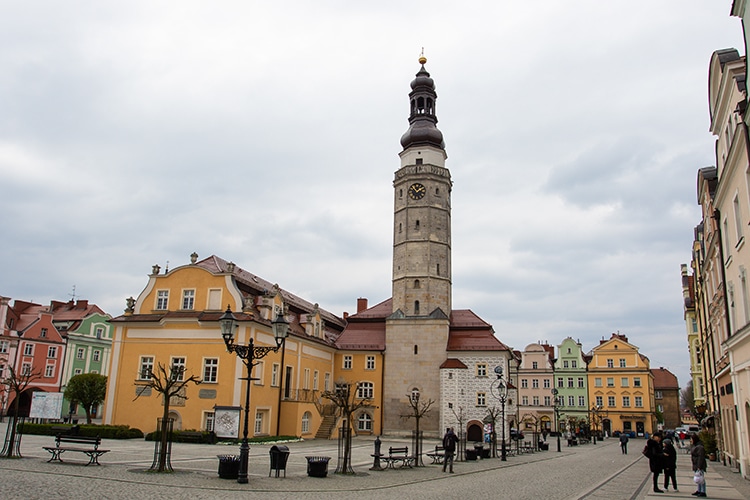
Bolesławiec, Poland. (Photo:Stock Photosfrom LIDIA MUHAMADEEVA/Shutterstock)
New techniques ofmolded reliefsglazed in white were added on top if the classic brown background of vessels.
Potters also experimented withcold-pained overlaysof heraldry and religious iconography.
The most influential figure in this development wasJohann Gottlieb Altmann.
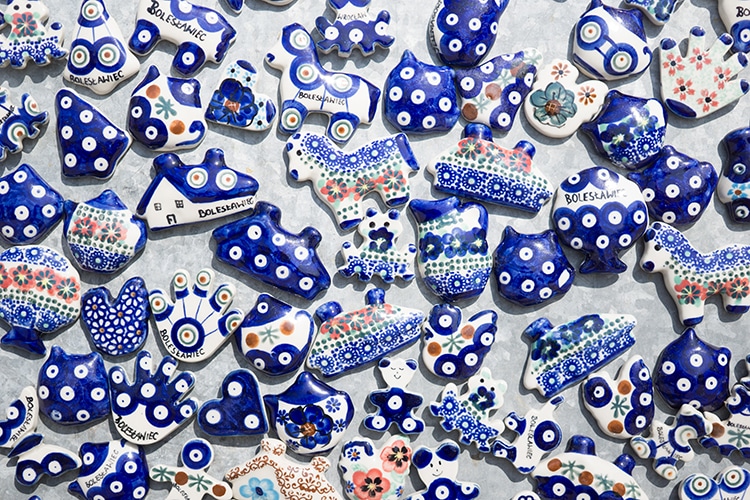
Magnets showing samples of Bolesławiec patterns, from the Ceramics Festival in 2017. (Photo:Stock Photosfrom MAGDALENAGALKIEWICZ/Shutterstock)
He also began tocastvessels rather than using traditional wheel techniques.
Inspired by classical designs, Altmann’s work won international recognition and inspired much interest in Bolesawiec pieces.
A royal pottery school was established in the city to further the craft.
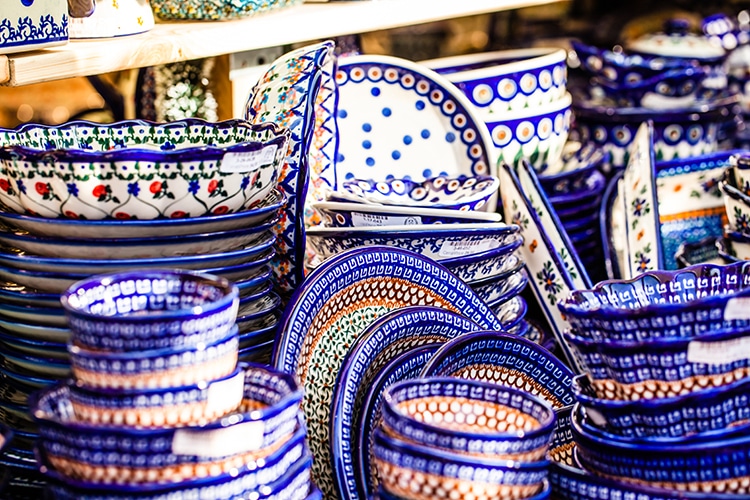
Photo:Stock Photosfrom CURIOSO.PHOTOGRAPHY/Shutterstock
It was during this period thatutilizing the clear feldspar glazethecobalt blue and whitepatterns were introduced.
Potters hand-cut sponges into designs, then slowly stamped their wares (hencespongeware).
The fine natural clay of the region was light enough to allow for such embellishment.
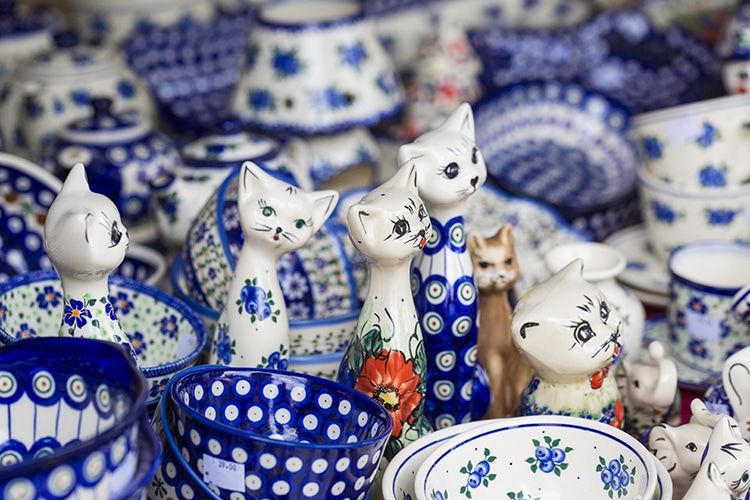
Photo:Stock Photosfrom CURIOSA.PHOTOGRAPHY/Shutterstock
The potters quickly incorporated popular organic motifs typical of theJugendstilperiod in Germanyknown to Americans asArt Nouveau.
Magnets showing samples of Bolesawiec patterns, from the Ceramics Festival in 2017.
(Photo:Stock Photosfrom MAGDALENAGALKIEWICZ/Shutterstock)
Production of the pottery encountered difficulties in the 20th century.
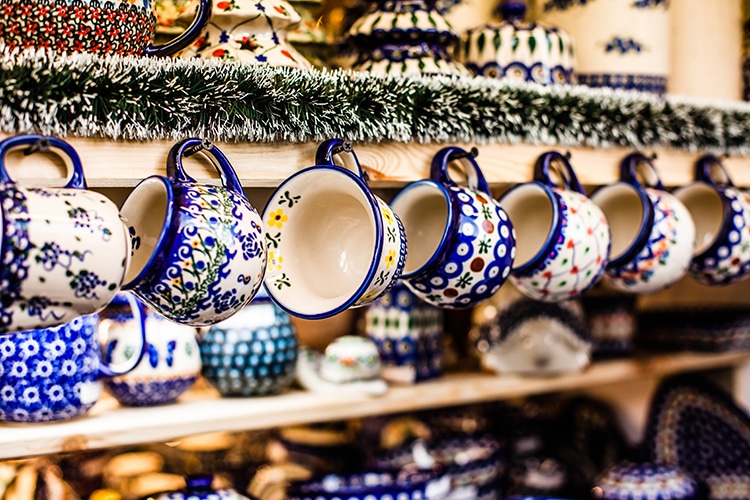
Photo:Stock Photosfrom CURIOSO.PHOTOGRAPHY/Shutterstock
The inter-war period in Germany was marked by a cratering economy.
World War II proved a radical shift in the history of both the region and Bolesawiec pottery.
A defeated Germany forfeited Silesia to Poland, and the German residents of Bolesawiec were expelled.
Manycontinuedtheir craft in East or West German towns, but Bolesawiec was left mostly bereft of artisans.
A strong Polish government effort began in 1946 to rescue the traditional folk art.
Factories were rebuilt and ceramic artists recruited from elsewhere in Poland.
Now undercommunist rule, pottery became a cooperative much like other production.
TheCPLiA Cooperativewas founded in 1950, and its training programs produced countless new artisans to carry on the craft.
A post-communism version of the cooperative is still active in producing traditional pottery today.
Photo:Stock Photosfrom CURIOSO.PHOTOGRAPHY/Shutterstock
Modern Production
Bolesawiec pottery is still produced today.
Often referred to internationally asPolish pottery, it is a popular collectable in the United States and internationally.
Each piece is hand-crafted, building on the long-established traditions of the region.
The pottery is still made from local white clay fired to extreme temperatures.
Each piece is hand-stamped with free-hand details and coated in a lead-free glaze.
The pottery may be very beautiful, but it is also extremelyusefulin the kitchen.
Today there are several well-establishedproducersof Bolesawiec wares, some of which date back to the post-war period.
As cheaperfake versionsmay appear, be sure to research a brand before purchasing a piece.
Each authentic piece should bestampedby the maker and have a distinct Made in Poland stamp.
Whatever your tastetraditional, modern, or bohemianartisans have created patterns that broad audiences are sure to find appealing.
These patterns can be found on virtually any ceramic form imaginable.
While they are durable,proper carewill preserve these stunning pieces for generations to come.
These pieces are identified asunikat, or unique.
They are often more expensive but make excellent additions to any collection.
About 70% of the artisans are women, so you will also be supporting them.
Other marketplace-style websites carry multiple brands, such asPolmediaandPolish Pottery House.
Many local shops in your city may also offer this lovely pottery.